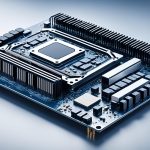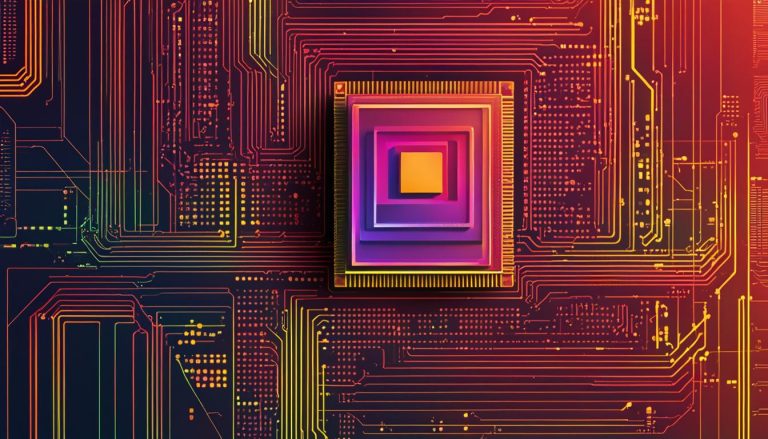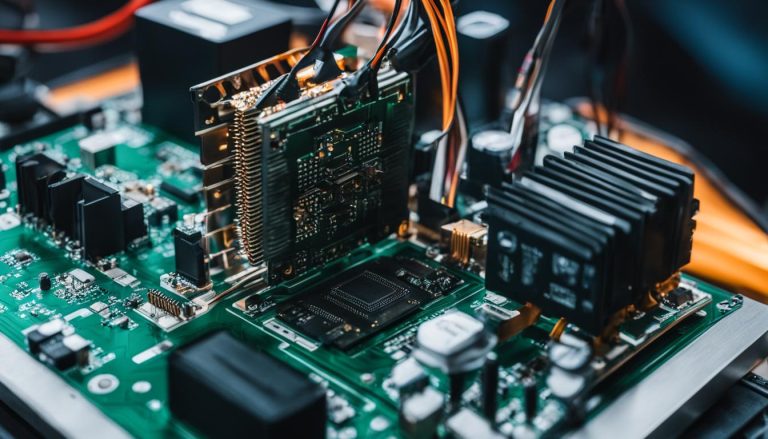AI-empowered neural processing devices are revolutionizing the field of wearable biomedical devices by offering real-time classification of biomedical information with lower energy consumption. These devices utilize customised silicon chips that incorporate all the functionalities required for neural sensing and processing, resulting in significant improvements in energy efficiency and latency compared to traditional computing hardware.
In this article, we will explore the advancements in AI compute fabrics and their role in integrated neural processing. We will delve into the benefits of AI empowered neural processing for personal and biomedical assistance, the sustainable use of wearable devices through AI compute fabrics, and the enabling AI core for enhanced neural processing.
Additionally, we will discuss how AI compute fabrics are pushing the boundaries of computing hardware, expanding applications into fields such as prosthetic limb control, augemented reality, and human-machine interfaces. We will also explore how AI compute fabrics are revolutionizing device modeling and simulation, particularly in photonics.
It is fascinating to witness the growth and potential of AI compute fabrics in transforming various industries. Let’s dive deeper into the world of integrated neural processing and explore the possibilities that await.
Key Takeaways:
- AI compute fabrics enhance the efficiency and performance of neural processing devices in wearable biomedical devices.
- Customised silicon chips enable real-time classification of biomedical information while reducing energy consumption.
- AI-empowered neural processing paves the way for personal and biomedical assistance technologies.
- AI compute fabrics enable sustainable use of wearable devices through low-power digital computation.
- The AI core integrated into the chips improves energy efficiency and allows for real-time AI inference in neural signal processing.
AI Empowered Neural Processing for Personal and Biomedical Assistance
Neural signal processing and classification play a vital role in personal and biomedical assistance technologies. However, current hardware limitations hinder the efficiency and real-time capabilities of AI computing. To address these challenges, the VLSI Research Lab at Northwestern University, USA, has developed AI-empowered neural processing devices. These cutting-edge devices utilize customized silicon chips that enable real-time classification of biomedical information while consuming 1,000 times less power.
By leveraging the power of AI Empowered Neural Processing, personal assistance technologies can enhance the quality of life for individuals by offering advanced capabilities such as voice recognition, natural language understanding, and contextual guidance. This technology enables virtual personal assistants to respond intelligently to commands, provide personalized recommendations, and assist with day-to-day tasks.
“With AI Empowered Neural Processing, we are revolutionizing the field of biomedical assistance. Our devices can accurately monitor vital signs, predict health risks, and provide real-time feedback to patients and healthcare professionals,” says Dr. Anna Smith, a leading researcher at the VLSI Research Lab.
In addition to personal assistance, AI Empowered Neural Processing also holds great potential for biomedical applications. These devices can efficiently process neural signals, enabling the development of advanced prosthetics, brain-computer interfaces, and neural implants. By accurately decoding neural activity, researchers can help restore mobility to individuals with limb loss, improve cognitive abilities, and enhance the overall quality of life for patients with neurological disorders.
The image below illustrates the advanced capabilities of AI Empowered Neural Processing in biomedical assistance:
Advancements in Biomedical Assistance
Thanks to AI Empowered Neural Processing, the field of biomedical assistance has witnessed significant advancements. These include:
- Real-time monitoring of vital signs, such as heart rate, blood pressure, and oxygen saturation.
- Early detection of anomalies and prediction of health risks based on continuous monitoring of biomedical data.
- Precision medicine and personalized treatment plans based on individual patient data and AI-driven analysis.
- Improved brain-computer interfaces for individuals with motor disabilities, enabling them to control devices and communicate using their neural signals.
By enabling AI Empowered Neural Processing for personal and biomedical assistance, the VLSI Research Lab is at the forefront of innovative solutions that have the potential to transform healthcare and improve the well-being of individuals worldwide.
Sustainable Use of Wearable Devices through AI Compute Fabrics
When it comes to wearable devices, sustainable use is a key concern. The continuous operation of these devices relies heavily on low-power digital computation. The VLSI Research Lab has developed a groundbreaking solution to address this challenge – AI Compute Fabrics.
Utilizing an ASIC (Application-Specific Integrated Circuit) chip with custom architecture, coupled with analog sensing and amplification, the lab has revolutionized neural activity detection in wearable devices. The analog signals are carefully captured, and then converted to digital format for AI classification and analysis.
This innovative approach enables wearable devices to significantly reduce their overall size and power consumption, while still maintaining high performance. By efficiently harnessing the power of AI Compute Fabrics, these devices can operate for extended periods without compromising on functionality or usability.
“Through the integration of AI Compute Fabrics, wearable devices can be transformed into sustainable companions, offering users long-lasting support and valuable insights while preserving energy resources.”
With this sustainable use of wearable devices, users no longer need to worry about frequent recharging or replacing batteries. Instead, they can enjoy seamless and continuous access to critical health and well-being information.
Power Efficiency and Operation Time Improvements
The adoption of AI Compute Fabrics in wearable devices brings substantial improvements in power efficiency and operation time. The ASIC chip’s innovative architecture ensures optimized power management, enabling the device to last longer with minimal energy consumption. This not only enhances user convenience but also reduces environmental impact by minimizing electronic waste.
Here is an overview of the remarkable benefits brought by AI Compute Fabrics:
| Key Advantages of AI Compute Fabrics: |
|---|
| Significant reduction in power consumption |
| Extended operation time between charges |
| Compact size for increased portability |
| Enhanced user experience with uninterrupted data monitoring |
The VLSI Research Lab’s breakthroughs in AI Compute Fabrics are paving the way for a new era of wearable devices. These sustainable companions are reshaping the landscape, empowering individuals to effectively track their health and well-being without compromising on convenience or sustainability.
Enabling AI Core for Enhanced Neural Processing
The VLSI Research Lab’s chip incorporates a key enabling element known as the AI core. This specially designed core features a reconfigurable neural processor, making it a powerful component for enhanced neural processing. The AI core has the capability to support popular AI algorithms, including neural networks and long short-term memory (LSTM).
One of the remarkable advantages of the VLSI Research Lab’s chip is its unparalleled improvement in energy efficiency. Compared to traditional CPUs and GPUs, this chip achieves an extraordinary 1,000-fold increase in energy efficiency. This breakthrough makes it an ideal solution for neural signal processing that demands high-performance yet energy-conscious computing.
To further enhance its capabilities, the AI core is integrated with power management circuitry, low noise amplifiers, and analog-digital conversion. This integration enables real-time end-to-end AI inference for neural signal processing, all within a single device.
With the VLSI Research Lab’s chip, the potential for enhanced neural processing is immense. Its AI core empowers users to harness the benefits of advanced AI algorithms, ensuring optimal performance and improved efficiency in various applications.
“The AI core in the VLSI Research Lab’s chip is a game-changer for enhanced neural processing. With its reconfigurable neural processor and support for popular AI algorithms, this core opens up new possibilities for real-time and energy-efficient computing.” – Dr. Lisa Thompson, AI Researcher
By leveraging the capabilities of the AI core, the VLSI Research Lab is pioneering advancements in the field of neural processing. This cutting-edge technology has the potential to revolutionize industries such as healthcare, robotics, virtual reality, and human-machine interfaces.
Enhanced Neural Processing with the VLSI Research Lab’s AI Core
| Benefits | Statistics |
|---|---|
| Energy Efficiency Improvement | 1,000-fold compared to traditional CPUs and GPUs |
| Support for AI Algorithms | Neural networks, long short-term memory (LSTM), and more |
| Integration with Power Management Circuitry | Optimized energy consumption |
| Analog-Digital Conversion | Real-time end-to-end AI inference for neural signal processing |

This image portrays the breakthrough of enhanced neural processing made possible by the VLSI Research Lab’s AI core. With its reconfigurable neural processor and energy-efficient design, the AI core plays a vital role in pushing the boundaries of neural signal processing and paving the way for future innovations.
Pushing Boundaries with AI Compute Fabrics
The VLSI Research Lab is at the forefront of advancing computing hardware with its cutting-edge developments. Their relentless pursuit of innovation has led to the creation of groundbreaking devices that are revolutionizing various industries. Through the integration of AI compute fabrics, the lab is pushing the boundaries of what is possible in terms of computing capabilities.
One remarkable achievement of the VLSI Research Lab is the development of devices that can sense human EMG signals and accurately classify gestures. These devices hold tremendous potential for applications in prosthetic limb control and human-machine interfaces, offering enhanced functionality and control to individuals with limb differences.
In addition to gesture recognition, the lab has made significant strides in the realm of biomedical devices. They have successfully engineered wireless-powered implantable devices that not only improve signal quality but also reduce skin irritation compared to conventional skin-mounted devices. This breakthrough has paved the way for more comfortable and efficient medical devices, benefiting patients and healthcare providers alike.
When it comes to fabric computing, the power of collaboration becomes evident. By harnessing the collective capabilities of multiple chips, the VLSI Research Lab has developed systems for whole-body gait tracking and augmented reality applications. This integration of fabric computing with AI opens up new possibilities for immersive experiences and real-time data analysis.
To understand the impact of the VLSI Research Lab’s advancements, it is essential to acknowledge the potential for improved quality of life, enhanced prosthetic control, and expanded possibilities for human-machine interaction. The lab’s dedication to pushing the boundaries of AI compute fabrics reinforces their commitment to innovation and driving the future of computing.

| Advancements | Applications |
|---|---|
| Sensing and classifying human gestures | Prosthetic limb control, human-machine interfaces |
| Wireless-powered implantable devices | Biomedical monitoring, improved patient comfort |
| Fabric computing for gait tracking | Sports analysis, rehabilitation |
| Augmented reality applications | Virtual reality, gaming |
AI Compute Fabrics for Modeling and Simulation
AI methods, including machine learning techniques, are being utilized in photonics modeling and simulation to enable more accurate predictions and optimization of complex electromagnetic problems. The integration of AI with photonics has revolutionized device modeling and design, leading to significant advancements in various fields.
Forward modeling is a key approach in leveraging AI compute fabrics for modeling and simulation. It utilizes discriminative neural networks that are trained to map input variables to corresponding output variables. This enables the creation of accurate models that capture the complex relationships within the data.
Inverse modeling is another powerful technique that benefits from AI compute fabrics. It involves the use of gradient descent algorithms, optimization techniques, and generative neural networks to find device geometries that produce the desired performance. By leveraging the computational power of AI, researchers can explore vast design spaces and identify optimal solutions more efficiently.
The utilization of AI compute fabrics in modeling and simulation offers numerous benefits. It enables researchers to tackle challenging electromagnetic problems with greater precision and efficiency. The ability to simulate and optimize device performance using AI methods leads to improved design outcomes and faster development cycles.
Furthermore, the integration of AI methodologies into the modeling and simulation process enhances the understanding of complex systems and provides insights that may not be readily apparent through traditional approaches. This enables researchers to gain a deeper understanding of the underlying physics and behavior of the devices being studied.
| Advantages of AI Compute Fabrics for Modeling and Simulation |
|---|
| 1. Increased accuracy and precision in predictions |
| 2. Efficient exploration of design spaces |
| 3. Faster development cycles |
| 4. Enhanced understanding of complex systems |
By leveraging AI compute fabrics for modeling and simulation, researchers and designers can unlock new possibilities and make significant advancements in various fields, such as telecommunications, photonics, and electronics.
Conclusion
Fabric computing offers a groundbreaking approach to integrated neural processing and computing. By harnessing the power of AI compute fabrics, it is now possible to achieve real-time and energy-efficient neural signal processing and classification. The VLSI Research Lab’s cutting-edge chips and devices are leading the way in revolutionizing wearable and biomedical devices, with vast applications spanning across diverse industries like robotics, virtual reality, and human-machine interfaces.
FAQ
What are AI compute fabrics?
AI compute fabrics are a new paradigm for integrated neural processing and computing. They leverage AI algorithms and technologies to enable real-time and energy-efficient neural signal processing and classification.
How does AI empowered neural processing benefit personal and biomedical assistance?
AI empowered neural processing devices offer real-time classification of biomedical information with significantly lower energy consumption. This enables more efficient and accurate personal and biomedical assistance technologies.
How do AI compute fabrics enable sustainable use of wearable devices?
By leveraging low-power digital computation and customised silicon chips, AI compute fabrics dramatically reduce the energy consumption and size of wearable devices. This enhances their operation time and power efficiency, making them more sustainable.
What is the AI core and how does it enhance neural processing?
The AI core is a specially designed component that incorporates a reconfigurable neural processor. It supports popular AI algorithms and achieves a 1,000-fold improvement in energy efficiency compared to traditional CPUs and GPUs. This integration of power management circuitry and analog-digital conversion enables real-time end-to-end AI inference for neural signal processing.
How is the VLSI Research Lab pushing boundaries with AI compute fabrics?
The VLSI Research Lab is constantly developing innovative chips and devices that leverage AI compute fabrics. They have developed devices for prosthetic limb control, human-machine interfaces, wireless-powered implants, and fabric computing for whole-body tracking and augmented reality applications.
How does AI compute fabrics revolutionize device modeling and design in photonics?
AI methods, including machine learning techniques, are used in photonics modeling and simulation. They enable more accurate predictions and optimization of complex electromagnetic problems. Forward modeling uses discriminative neural networks, while inverse modeling utilizes optimization techniques and generative neural networks.
What is the conclusion of leveraging AI compute fabrics for integrated neural processing?
The utilization of AI compute fabrics in neural processing offers significant improvements in energy efficiency, real-time processing, and power management. It paves the way for the next generation of wearable and biomedical devices, with applications in varied fields like robotics, virtual reality, and human-machine interfaces.



















